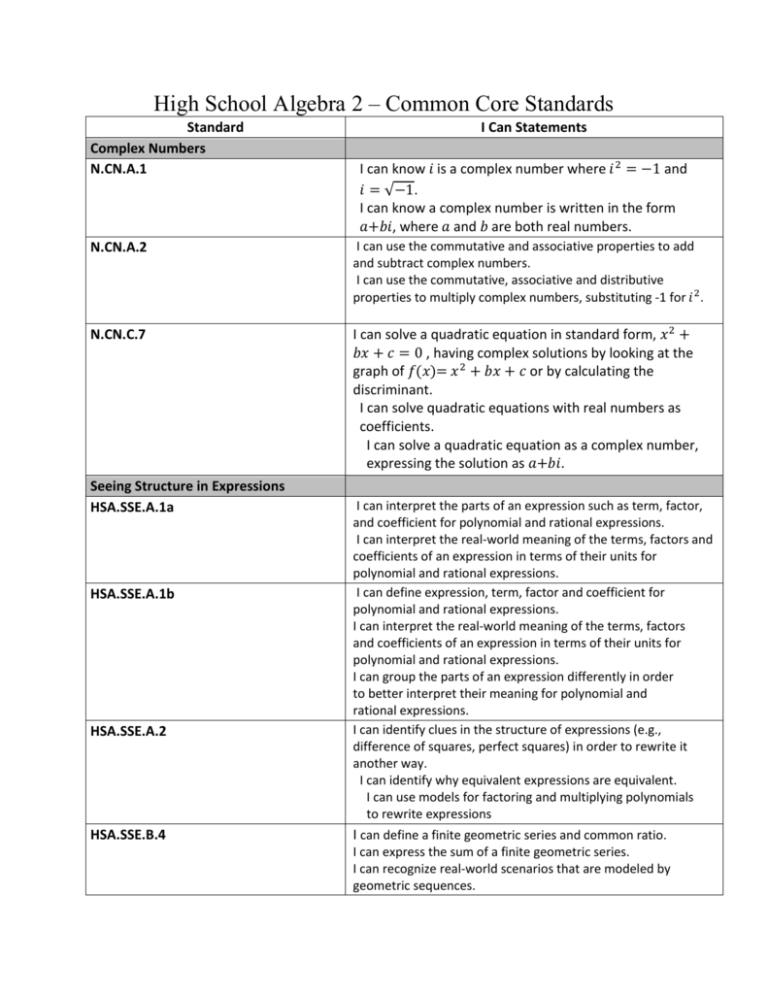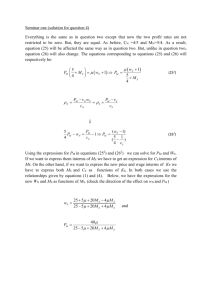Can
advertisement

High School Algebra 2 – Common Core Standards Standard Complex Numbers N.CN.A.1 I Can Statements I can know 𝑖 is a complex number where 𝑖 2 = −1 and 𝑖 = √−1. I can know a complex number is written in the form 𝑎+𝑏𝑖, where 𝑎 and 𝑏 are both real numbers. N.CN.A.2 I can use the commutative and associative properties to add and subtract complex numbers. I can use the commutative, associative and distributive properties to multiply complex numbers, substituting -1 for 𝑖 2 . N.CN.C.7 I can solve a quadratic equation in standard form, 𝑥 2 + 𝑏𝑥 + 𝑐 = 0 , having complex solutions by looking at the graph of 𝑓(𝑥)= 𝑥 2 + 𝑏𝑥 + 𝑐 or by calculating the discriminant. I can solve quadratic equations with real numbers as coefficients. I can solve a quadratic equation as a complex number, expressing the solution as 𝑎+𝑏𝑖. Seeing Structure in Expressions HSA.SSE.A.1a HSA.SSE.A.1b HSA.SSE.A.2 HSA.SSE.B.4 I can interpret the parts of an expression such as term, factor, and coefficient for polynomial and rational expressions. I can interpret the real-world meaning of the terms, factors and coefficients of an expression in terms of their units for polynomial and rational expressions. I can define expression, term, factor and coefficient for polynomial and rational expressions. I can interpret the real-world meaning of the terms, factors and coefficients of an expression in terms of their units for polynomial and rational expressions. I can group the parts of an expression differently in order to better interpret their meaning for polynomial and rational expressions. I can identify clues in the structure of expressions (e.g., difference of squares, perfect squares) in order to rewrite it another way. I can identify why equivalent expressions are equivalent. I can use models for factoring and multiplying polynomials to rewrite expressions I can define a finite geometric series and common ratio. I can express the sum of a finite geometric series. I can recognize real-world scenarios that are modeled by geometric sequences. I can use the formula for the sum of a finite geometric series to solve real-world problems. I can derive the formula for the sum of a finite geometric series, 𝑆𝑛 = Creating Equations HSA.CED.A.1 HSA.CED.A.2 HSA.CED.A.3 HSA.CED.A.4 Reasoning with Equations & Inequalities HSA.REI.A.2 HSA.REI.D.11 Trigonometry F.TF.A.1 𝑎1 (1−𝑟 𝑛 ) (1−𝑟) I can create equations and inequalities in one variable. I can create equations and inequalities in one variable and use them to solve problems. I can represent the variables and quantities represented in a real-world problem. I can create coordinate axes using an appropriate scale and label the axes. I can graph equations on coordinate axes with appropriate labels and scales. I can choose the best model to represent for the real-world problem. I can create equations in two or more variables that represent relationship between quantities I can represent the variables and quantities represented in a real-world problem for simple root and rational equations. I can represent the system of equations that fits within the constraints of the problem for simple root and rational equations. I can interpret solutions in the context of the situation modeled and decide if they are viable or non-viable options for simple root and rational equations. I can rearrange formulas for a specified variable in simple root and rational equations. I can solve a simple equation in one variable. I can give examples of equations with extraneous solutions. I can explain that since 𝑦 = 𝑓(𝑥) 𝑎𝑛𝑑 𝑦 = 𝑔(𝑥), 𝑓(𝑥) = 𝑔(𝑥) by the substitution property. I can explain that a point of intersection on the graph of a system of equations, 𝑦 = 𝑓(𝑥) 𝑎𝑛𝑑 𝑦 = 𝑔(𝑥), represents a solution to both equations. I can define unit circle, central angle, and arc. I can define the radian measure of an angle. I can extend the definition of radian measure to show that an angle measure of one radian occurs when the length of the arc and the radius of the circle are the same. I can use a similarity approach to find the radian measure of central angles in circles that are not unit circles. F.TF.A.2 F.TF.B.5 F.TF.C.8 Interpreting Functions HSF.IF.B.4 HSF.IF.B.5 HSF.IF.B.6 I can convert between degrees and radians. I can label the unit circle in radians. I can recall on the unit circle the cosine of an angle is defined to be the x-coordinate and the sine of the angle is the ycoordinate of the point where the angle crosses the unit circle. I can identify the cosine and sine of an angle when given a graph. I can define co-terminal angles. I can identify co-terminal angles when given a radian measure or degree measure. I can explain how the unit circle definitions of sine and cosine allow for negative values and why the right triangle definitions do not. I can define amplitude, frequency, and midline of a trigonometric function. I can explain the connection between frequency and period. I can use function notation for the trigonometric function that models a problem situation, given amplitude, frequency (or period), and midline of a periodic situation. I can recognize real-world situations that can be modeled with a periodic function by identifying the amplitude, frequency (or period), and midline. I can use a trigonometric model to make a prediction in a given situation. I can use the Pythagorean Identity to calculate the value of 𝑠𝑖𝑛(𝜃) 𝑎𝑛𝑑 𝑐𝑜𝑠(𝜃). sin 𝜃 I can use 𝑡𝑎𝑛(𝜃) = to calculate 𝑡𝑎𝑛(𝜃). cos 𝜃 I can derive the Pythagorean identity 𝑠𝑖𝑛2 (𝜃) + 𝑐𝑜𝑠 2 (𝜃) = 1 by using the unit circle definitions of cosine, sine and the Pythagorean Theorem. I can interpret the information that explains what each quantity represents. I can interpret the key features of a function as they relate to a graph, table, and relationship. I can sketch a graph that matches the verbal description and indicates all of the key features of the function. I can identify the domain of a function. I can relate how the domain of a function is represented in its graph. I can relate the appropriate domain of a function and how it is represented in a problem situation. I can calculate the average rate of change of a function over a specified interval. I can estimate the average rate of change of a function on a graph, over a specific input interval. I can calculate the average rate of change of a function when represented with function notation symbolically or with a table. I can interpret the connection between the average rate of change and the slope formula: 𝑓(𝑥) = HSF.IF.C.7b HSF.IF.C.7c HSF.IF.C.7e HSF.IF.C.8b HSF.IF.C.9 Building Functions HSF.BF.A.1b 𝑦2 − 𝑦1 𝑥2 − 𝑥1 = 𝛥𝑦 𝛥𝑦 ∆𝑥 = 𝑓(𝑏)−𝑓(𝑎) 𝑏−𝑎 ∆𝑥 I can interpret the meaning of the average rate of change (using units) as it relates to a real-world problem. I can identify square root, cube root, and piece‐wise defined functions that are relatively easy to graph accurately by hand and functions that should be graphed using technology. I can graph square root, cube root, and piece‐wise defined function, by hand or using technology as appropriate. I can identify polynomial functions that are relatively easy to graph accurately by hand and functions that should be graphed using technology. I can show the key features of a polynomial function by identifying the x-intercept(s), y-intercepts, and showing the end-behavior by looking at its graph. I can graph a polynomial function, by hand or using technology as appropriate and find values for the xintercept(s), y-intercepts, and show the end-behavior. I can decide which functions are relatively easy to sketch accurately by hand and which functions should be graphed using technology. I can identify the x-intercept(s), y-intercepts, increasing intervals, decreasing intervals, the maximums, the minimums of a function by looking at its graph. I can explain that the parent function for cube root functions 3 is the function (𝑥) = √𝑥 . I can distinguish between exponential functions that model exponential growth and exponential decay. I can interpret the components of an exponential function in the context of a problem. I can use the properties of exponents to rewrite an exponential function to emphasize one of its properties. I can identify properties of a function, such as max/min, zeros, increasing, decreasing, and end behavior of polynomials. I can compare properties of two functions when represented in different ways (algebraically, graphically, numerically in tables, or by verbal descriptions). I can combine standard function types using arithmetic operations. I can combine standard function types using arithmetic operations to write a function that describes a real-world problem.









